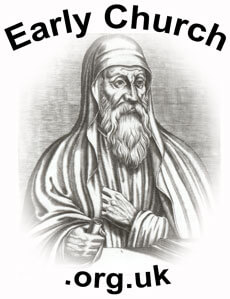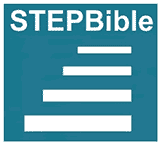Hermas' Shepherd
Theology on the Web helps over 2.5 million people every year to find high quality theological resources that will help to equip them to serve God and to know Him better (2 Timothy 2:15). Like other websites that provide free services, it is dependent on donations to enable it to grow and develop and only 0.004% of visitors currently do so. If you would like to support this site, please use one of the options to the right of this message.
Synopsis
HERMAS Pilgrim’s Progress of the Church of the second century," Dean Stanley], a name under which a book has come down to us, called the Shepherd (pastor, …), and held in high esteem by the early Church [quoted by Irenaeus, Clement of Alexandria, Origen, etc.]. The title Shepherd evidently was derived from the first words of the angel to the author, "I am the shepherd" …
Text. - We are now in possession of two Greek copies, - the one in the Sinaitic manuscript, discovered 1859 (not complete); the other in the Leipzig manuscript, together with three pages found on Mount Athos. Editions appeared at Leipzig by RUD. ANGER(1856), TISCHENDORF (1856), DRESSEL(1863), HILGENFELD(1866), [2d ed. 1881]. There are two Latin translations, —the Vulgata and the Palatina (in the Vatican Library). The Vulgata was first edited by Faber Stapulensis, Paris, 1513; since then many times. Rilgenfeld’s edition (Leipzig, 1873) is critical. D’Abbadie issued an Ethiopic translation, Leipzig, 1860. its probable date is 543. The edition of Gebhardt and Harnack (Patres Apost., Leipzig. 1877), based upon the Sinaitic manuscript, is the best.
Contents. - The book contains a number of visions accorded to Hermas. Their intent is to arouse Hermas, and the Church through him, to repentance. The time of repentance is limited, and will soon be at an end. The uniformity of style stamps the whole as one composition. The author divides the book into two parts; an aged woman explaining the visions of the first part, an angel those of the second. The visions contain revelations, commandments (to believe in the one God, practise alms, avoid falsehood and fornication, etc.), and similitudes. Hermas was neither a Judaizing Christian (Schwegler, Lipsius), nor an intense Paulinian, but a member of the orthodox church of his day.
Authorship. - The opinions may be reduced to four: (1) Relying upon the testimony of the Muratorian canon, a real Hermas, the brother of Bishop Pius (139-154), was author (Heyne, Gebhardt, Harnack); (2) Relying upon the statement in the book itself (Vis. II. 4, 3), that Herinas delivered the book to Clement, assumed to be Clement of Rome, the author is regarded as having been his contemporary (Gaab, Caspari, Alzog, Zahn); (3) Hermas wrote his book under Pius, but gave himself out for a contemporary of Clement, or for the Hermas of Rom. xvi. 14 (Behm, Ewald, Credner, Ritsehl, Hefele, Dorner, Thicrsch); (4) an unknown author of the second century who simulated the old Hermas (Schwegler, Lechler, Hilgenfeld, Lange, Donaldson). We hold to the first view, on the ground of the explicit statement in the Muratorian canon. The Clement referred to in the book is not necessarily Clement of Rome. The condition of the Church represented is that of the first half of the second century, with its Gnostic errors and its hypocrites. The work was probably written about 130, for we are not shut up to the period between 139-154, which, according to Lipsius, was the term of Pius’ administration. Pius was not bishop in our sense, but a prominent presbyter. The book of Hermas speaks only of presbyters in the Roman Church (comp. Vis. II. 2, 6; III. 8, etc.).
Uhlhorn, "EPIPHANIUS," Philip Schaff, ed., A Religious Encyclopaedia or Dictionary of Biblical, Historical, Doctrinal, and Practical Theology, 3rd edn., Vol. 2. Toronto, New York & London: Funk & Wagnalls Company, 1894. p.977.
Primary Sources
Secondary Sources
 David E. Aune, Prophecy in
Early Christianity and the Ancient Mediterranean World. Grand Rapids:
Eerdmans, 1991. Pbk. ISBN: 080280635X. pp. 299-310. David E. Aune, Prophecy in
Early Christianity and the Ancient Mediterranean World. Grand Rapids:
Eerdmans, 1991. Pbk. ISBN: 080280635X. pp. 299-310. |
|
| L.W. Barnard, "The Shepherd of Hermas in Recent Study," Heythrop Journal, Vol. 9 (1968): 29-36. | |
| Richard .J. Bauckham, "The Great Tribulation in the Shepherd of Hermas," Journal of Theological Studies, n.s. Vol. 25 (1974): 27-40. | |
| Charles Bigg [1840-1908], The Origins of Christianity. Oxford: Clarendon Press, 1909. Hbk. pp.72-84. | |
| Henry Chadwick, "The New Edition of Hermas," Journal of Theological Studies 8 (1957): 274-280. | |
| Hermas (John Chapman) | |
| F.L. Cross, The Early Christian Fathers. Studies in Theology 1. London: Gerald Duckworth & Co. Ltd., 1960. Hbk. pp.23-27. | |
![William John Ferrar [1868-1945], The Early Christian Books. Handbooks of Christian Literature](images/books3/early-christian-books_ferrar-tb.jpg) William John Ferrar [1868-1945], The Early Christian Books. Handbooks of Christian Literature. London: SPCK, 1919. Hbk. pp.108. William John Ferrar [1868-1945], The Early Christian Books. Handbooks of Christian Literature. London: SPCK, 1919. Hbk. pp.108. |
|
| Josephine Massingberd Ford, "A Possible Liturgical Background to the Shepherd of Hermas," Revue de Qumran 6.24 (1969): 531-551. | |
![James Rendel Harris 1852-1941], Hermas in Arcadia and Other Essays](images/books3/hermas-in-arcadia_harris-tb.jpg) James Rendel Harris 1852-1941], Hermas in Arcadia and Other Essays. Cambridge: Cambridge University Press, 1986. Hbk. pp.83. James Rendel Harris 1852-1941], Hermas in Arcadia and Other Essays. Cambridge: Cambridge University Press, 1986. Hbk. pp.83. |
|
| Robert J. Hauck, "The Great Fast: Christology in the Shepherd of Hermas," Anglican Theological Review 75.2 (1993): 187-198. | |
![Henry Scott Holland [1847-1918], The Apostolic Fathers. The Fathers for English Readers](images/books3/apostolic-fathers_holland-tb.jpg) Henry Scott Holland [1847-1918], The Apostolic Fathers. The Fathers for English Readers. London: SPCK, 188?. Hbk. pp.223. Henry Scott Holland [1847-1918], The Apostolic Fathers. The Fathers for English Readers. London: SPCK, 188?. Hbk. pp.223. |
|
![Fenton John Anthony Hort [1828–1892], Six Lectures on the Ante-Nicene Fathers](images/books3/ante-nicene-fathers_hort-tb.jpg) Fenton John Anthony Hort [1828–1892], Six Lectures on the Ante-Nicene Fathers. London & New York: MacMillan & Co., 1895. Hbk. pp.138. Fenton John Anthony Hort [1828–1892], Six Lectures on the Ante-Nicene Fathers. London & New York: MacMillan & Co., 1895. Hbk. pp.138. |
|
| The Shepherd of Hermas (Peter Kirby) | |
| Alastair Kirkland, "The Literary History of the Shepherd of Hermas, Visions I to IV," Second Century 9.3 (1992): 87-102. | |
| Patricia Cox Miller, "'All the Words Were Frightful': Salvation by Dreams in the Shepherd of Hermas," Vigiliae Christianae 42.4 (1988): 327-338. | |
| H.P.V.
Nunn, "The 'Shepherd' of Hermas," The Evangelical Quarterly 18.2 (April
1946): 109-122. |
|
| D.P. O'Brien, "The Cumaean Sibyl as the Revelation-Bearer in the Shepherd of Hermas," Journal of Early Christian Studies 5.4 (1997): 473-496. | |
| Carolyn Osiek, "The Genre and Function of the Shepherd of Hermas," Semeia 36 (1986): 113-121. | |
| Carolyn Osiek, "The Second Century through the Eyes of Hermas: Continuity and Change," Biblical Theology Bulletin 20.3 (1990): 116-122. | |
| Carolyn Osiek, "The Shepherd of Hermas," Bible Review 10.5 (1994): 49-54. | |
| Carolyn Osiek, "The Shepherd of Hermas in Context," Acta Patristica et Byzantina 8 (1997): 115-134. | |
 Carolyn Osiek, Shepherd Of
Hermas. Augsburg / Fortress, 1998. Hbk. ISBN: 0800660633. pp.400. Carolyn Osiek, Shepherd Of
Hermas. Augsburg / Fortress, 1998. Hbk. ISBN: 0800660633. pp.400. |
|
| Carolyn Osiek, Rich and Poor in the Shepherd of Hermas: An Exegetical-Social Investigation. Washington, D.C.: Catholic Biblical Association, 1983. Pbk. ISBN: 0915170140. pp.184. | |
| J. Reiling, Hermas and Christian Prophecy: A Study of the Eleventh Mandate. Novum Testamentum , Supplement 37. Leiden: Brill, 1973. Hbk. ISBN: 9004037713. pp.197. | |
| O.J.F. Seitz, "Relationship of the Shepherd of Hermas to the Epistle of James," Journal of Biblical Literature 63 (1944): 131-40. | |
| Graydon F. Snyder, The Shepherd of Hermas. New York: Nelson, 1968. pp.165. | |
| R.G. Tanner, "Latinisms in the Text of Hermas," Colloquium, Auckland 4/4 (1972): 12-23. | |
| Joseph Verheyden, "The Shepherd of Hermas," The Expository Times 117.10 (2006): 397-401. [Abstract] | |
| Steve Young, "Being a Man: The Pursuit of Manliness in The Shepherd of Hermas," Journal of Early Christian Studies 2.3 (1994): 237-255. |
Related Subjects
 |
|
 |
|
 |





 Shepherd of Hermas;
Martyrdom of Polycarp; Epistle to Diognetus. Apostolic Fathers, Volume 2.
Loeb Classsical Library. Cambridge, Massachusetts: Harvard University Press,
1976. Hbk. ISBN: 0674990285. pp.396.
Shepherd of Hermas;
Martyrdom of Polycarp; Epistle to Diognetus. Apostolic Fathers, Volume 2.
Loeb Classsical Library. Cambridge, Massachusetts: Harvard University Press,
1976. Hbk. ISBN: 0674990285. pp.396. Kirsopp Lake, translator, The Apostolic Fathers. I Clement, II Clement, Ignatius, Polycarp, Didache, Barnabas, The Shepherd of Hermas, The Martyrdom of Polycarp, The Epistle to Diognetus, 2 Vols. London: William Heinemann, 1925. Hbk. pp.409+396.
Kirsopp Lake, translator, The Apostolic Fathers. I Clement, II Clement, Ignatius, Polycarp, Didache, Barnabas, The Shepherd of Hermas, The Martyrdom of Polycarp, The Epistle to Diognetus, 2 Vols. London: William Heinemann, 1925. Hbk. pp.409+396. ![Alexander Roberts [1826-1901] & James Donaldson [1831-1915], eds., The Ante-Nicene Fathers, Translations of the Fathers down to A.D. 325, Vol. 2](images/books3/ante-nicene-fathers_vol-02-tb.jpg) Alexander Roberts [1826-1901] & James Donaldson [1831-1915], eds., The Ante-Nicene Fathers, Translations of the Fathers down to A.D. 325, Vol. 2: Fathers of the Second Century: Hermas, Tatian, Athenagoras, Theophilus, and Clement of Alexandria (Entire). Buffalo, NY: The Christian Literature Publishing Company, 1887. Hbk. pp.626.
Alexander Roberts [1826-1901] & James Donaldson [1831-1915], eds., The Ante-Nicene Fathers, Translations of the Fathers down to A.D. 325, Vol. 2: Fathers of the Second Century: Hermas, Tatian, Athenagoras, Theophilus, and Clement of Alexandria (Entire). Buffalo, NY: The Christian Literature Publishing Company, 1887. Hbk. pp.626. 


